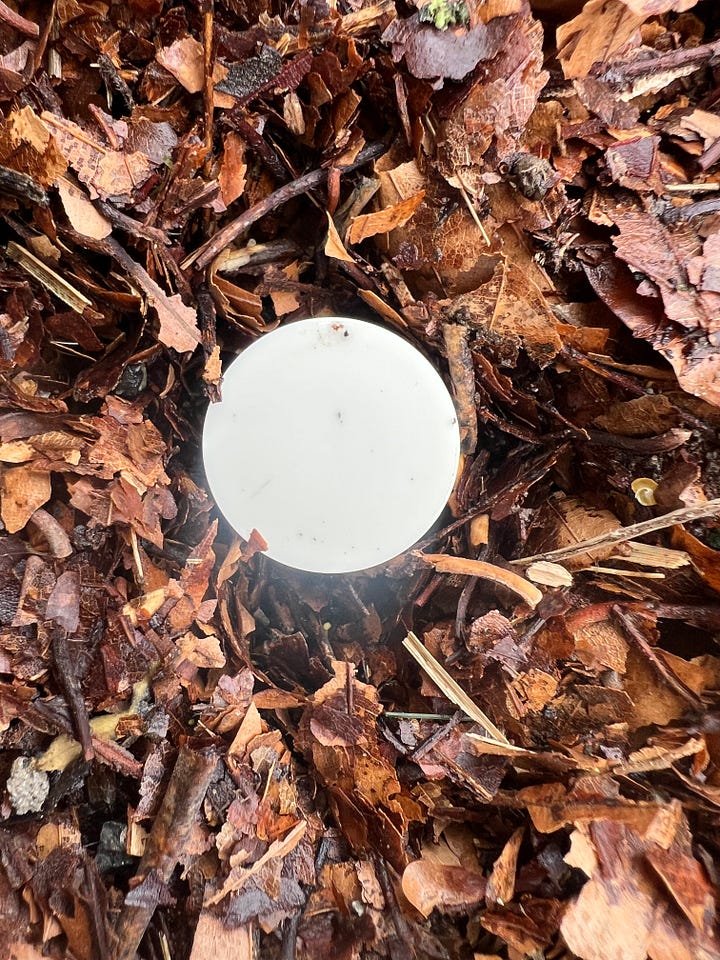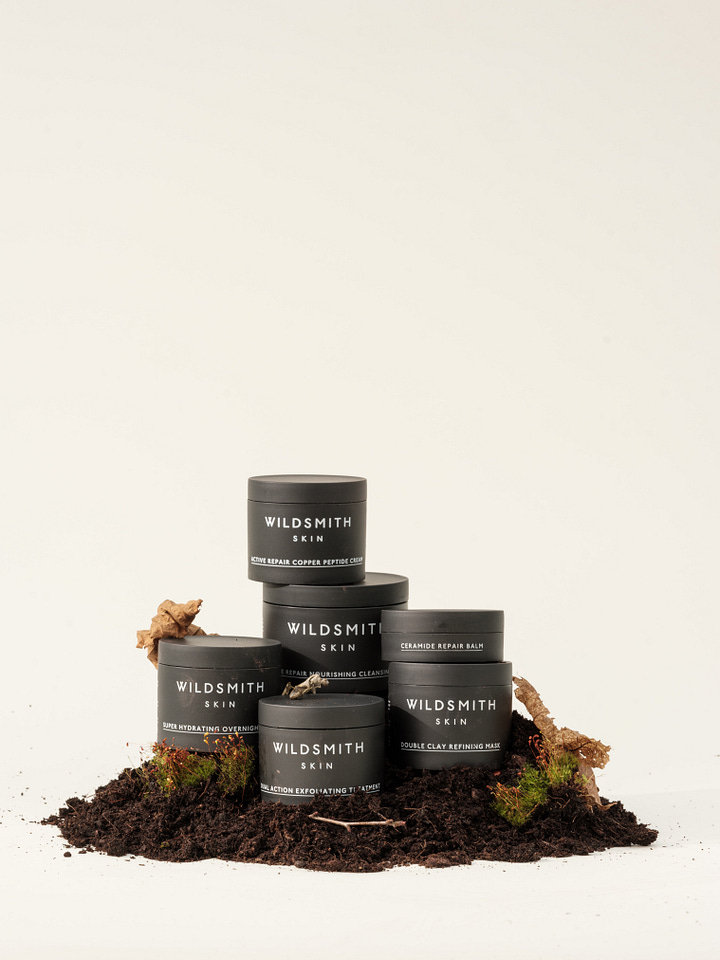In a corner of my garden there is a heap of soil, brown cardboard, grass cuttings, raked-up leaves, eggshells, cabbage leaves and coffee granules. And somewhere in the middle of all that, is one of the lids from my perfume bottles. If you could fish it out now, and wash off all the mud, you’d see what was once a perfectly formed, shiny cream plastic lid, slowly deteriorating. Not quite before your very eyes, but furring up around the edges, looking a little sorry for itself, not quite yet convinced of its future purpose: that it will one day be re-used on my vegetable patches, as compost.
As mind-blowing as this circle of life is, it’s all thanks to a small British brand called Shellworks, founded by Insiya Jafferjee and Amair Afshar who met while working on their master’s degrees in Innovation and Design Engineering at the Royal College of Art and Imperial College. They initially worked with seashells, extracting biopolymers to develop eco-friendly plastic solutions, with the mission of making wasted plastic a thing of the past. But seashells have a limited supply, they’re not vegan, and so they quickly moved on because… what if they could find some other natural material? Enter Vivomer, which is made from microbial fats, and yet is stable until it meets an untimely/timely demise in the form of a compost heap, or indeed, any other microbial collection deep enough to swamp it and activate its decomposition.
It was Amy Christiansen who first told me about Shellworks. Over the years, the founder and CEO of Sana Jardin, a beautiful fragrance brand with a philanthropic heart as big as its olfactive soul, she has been one of my most generous mentors, sharing her time and her insights. (If you’d like to find out more about her own pressure points with Sana Jardin, you might enjoy the podcast we recorded around a year ago).
Shellworks came up in conversation because one of my objectives with La Pyae was to make it as sustainable as we could. I wanted to avoid plastic wherever possible, because as we all know, while it’s one of the greatest inventions, its environmental legacy has also been one of the worst. How bad is it? 7.4 billion tons of waste and over 4200 toxic chemicals worth of bad, as Shellworks puts it.


I didn’t intend to shout about our environmental credentials because, well, shouldn’t this just be a given? Shouldn’t all new brands endeavour to be as sustainable as they can? And also, because frankly, every brand can do better, and we’re no exception. (Our long term goals will be refillable bottles, and finding a better alternative for the spray-pump in our bottles). But around a month ago, I went to a breakfast hosted by Wildsmith Skin, which focused on their collaboration with Shellworks and I thought to myself, “I should be shouting too about Shelloworks because they’re incredible!” Sometimes it takes seeing what you have through someone else’s eyes to make you sit up and take note.
Above: Insiya Jafferjee, Shellworks, with Katherine Pye, Wildsmith Skin
At the breakfast, held in Spring, the Skye Gyngell restaurant in Somerset House, Wildsmith Skin’s GM Katherine Pye and Jafferjee (as well as Alexander Smith from the Sustainability Group) were all interviewed by journalist Lucy Siegle. (By the way, she is a brilliant writer on all matters to do with sustainability, her piece on sunscreen recently in Luxe was what I call cut-out-and-keep journalism, so well researched, thorough and readable).
Jafferjee talked us through the process that took Shellworks to where they are today, with a product - Vivomer - she describes as “almost too good to be true.”
“Vivomer is Nature’s way of saying “We have made you a plastic!,” she says “It’s as if Nature’s saying, “Please use it! Because we can digest it, we have the microorganisms in our natural environment!””
Within nature, microorganisms derived from plants build up granules inside their cells that resemble plastic granules. Shellworks comes along and grows these granules on a large scale, extracts them, and then formulates the resulting bio-polymers so that manufacturers can use them exactly like normal plastic. With one big upside - unlike normal plastic, this one can degrade in a natural environment. Throw it in your compost and couched in all the other bacteria, it breaks down. Remarkably, when it’s not in this environment, it exists like any other plastic, you can throw it in the dishwasher, or, in the case of Catch Me If I Fall, pop it back on top of your perfume bottle. It’s durable, lasts forever, and looks just the same as plastic.
There are some incredible ideas out there, many of which are born from good intentions but are they always as sustainable as they look? Sometimes the design isn’t quite there. As Katharine Pye elaborated in the talk at Spring, “Lots of people knock on our doors.” She was once sent shampoo and conditioner bottles that looked incredibly hard-wearing, but while the conditioner was fine, the shampoo ended up dissolving before her eyes. Wildsmith’s championing of Shellworks takes it to a new level - pots with lids! Shellworks’s Vivomer houses their best-selling Active Repair Copper Peptide Cream and their Ceramide Repair Balm.


So why isn’t everyone using it? Being sustainable isn’t as obvious as it looks. In my limited time as a business founder, I could have halved many of my costs just by making things in China. Honestly, for all the talk of how best to help new brand founders, entrepreneurship, new industry, whatever, I don’t understand why there isn’t more support for brands prioritising sustainability. I was lucky, I had Angel investors who believed as much in it as I did, but imagine if there were grants available to brands willing to make these innovative choices? You’d be helping these brands make environmentally decisions, but also you’d be helping these small inventive tech brands like Shellworks, scale up more quickly. That’s two brands growing for the greater good, for the price of one. And once they scale, the big brands can come in and work with them, and suddenly their costs would be able to come down, and everyone would be working with them, and as if by magic, a green planet! (Did you like what I did there?!)
“We are in a chicken and egg situation,” says Jafferjee. “Last year we did a million units, which was monumental for us, because we were able to bring down the scale quite dramatically. A lot of people don’t believe it’s possible to do what we’re doing, and yet it is, even restricting ourselves to using only non-petrochemical additives. That’s hard for people to get their heads round.”
If you know anyone looking at starting a new brand, please do the planet a favour, and forward them this Substack. I’m excited that our perfume caps will have an afterlife of sorts, that they won’t damage the planet, even if they end up in landfill. It’s such a small thing, but it makes me feel a little better about the world.






